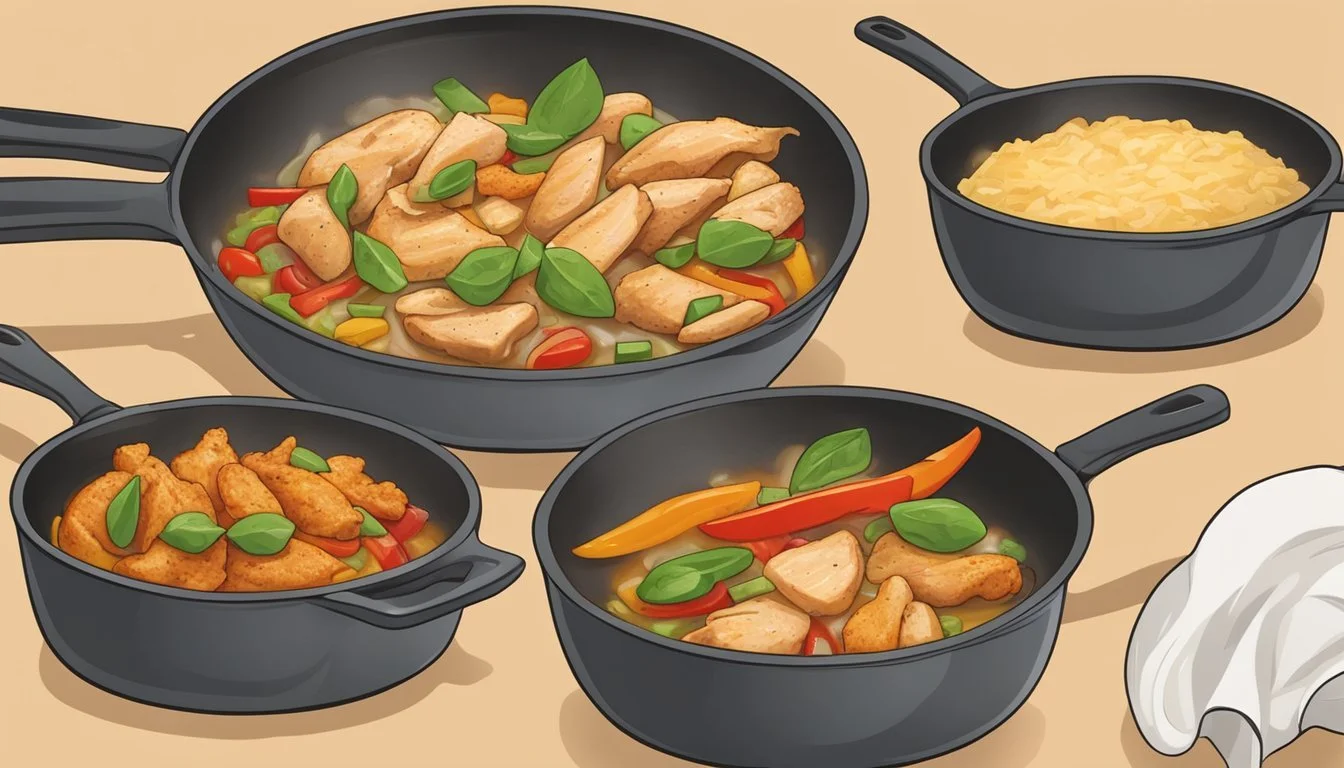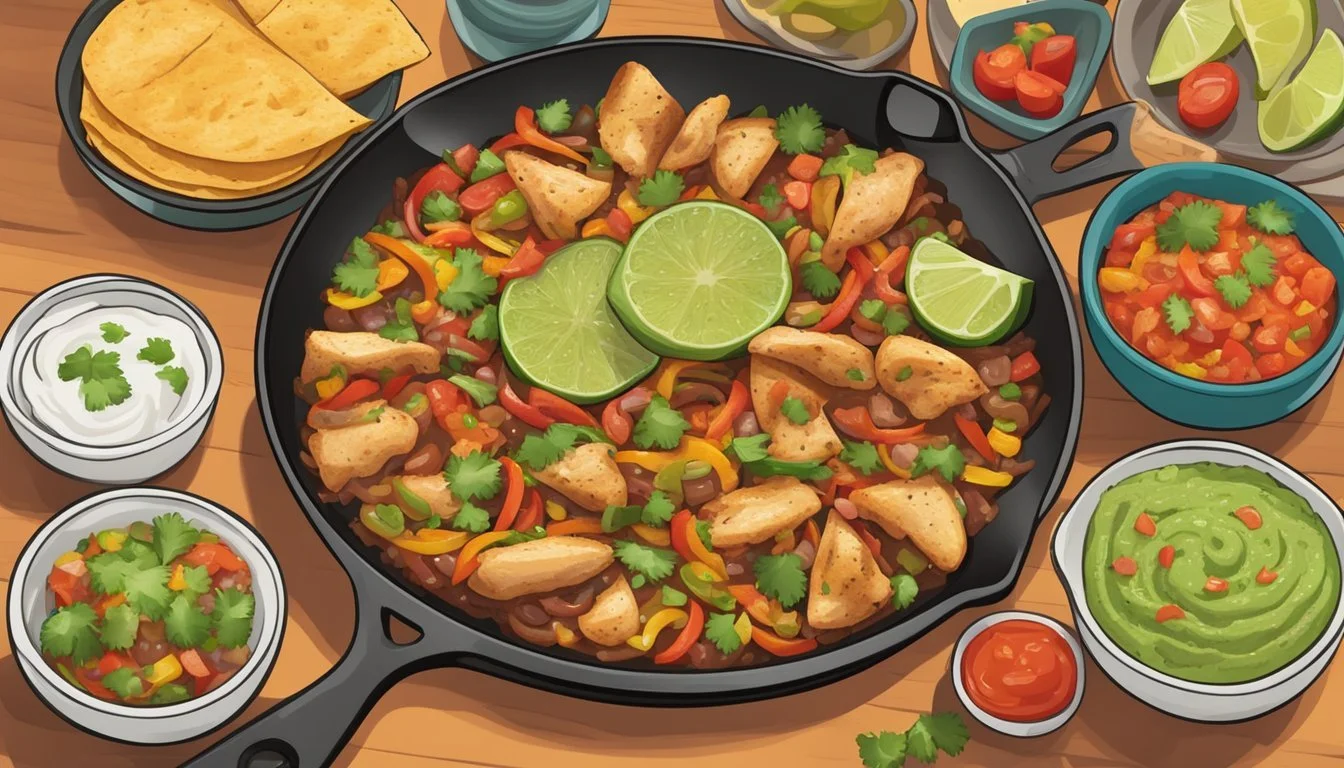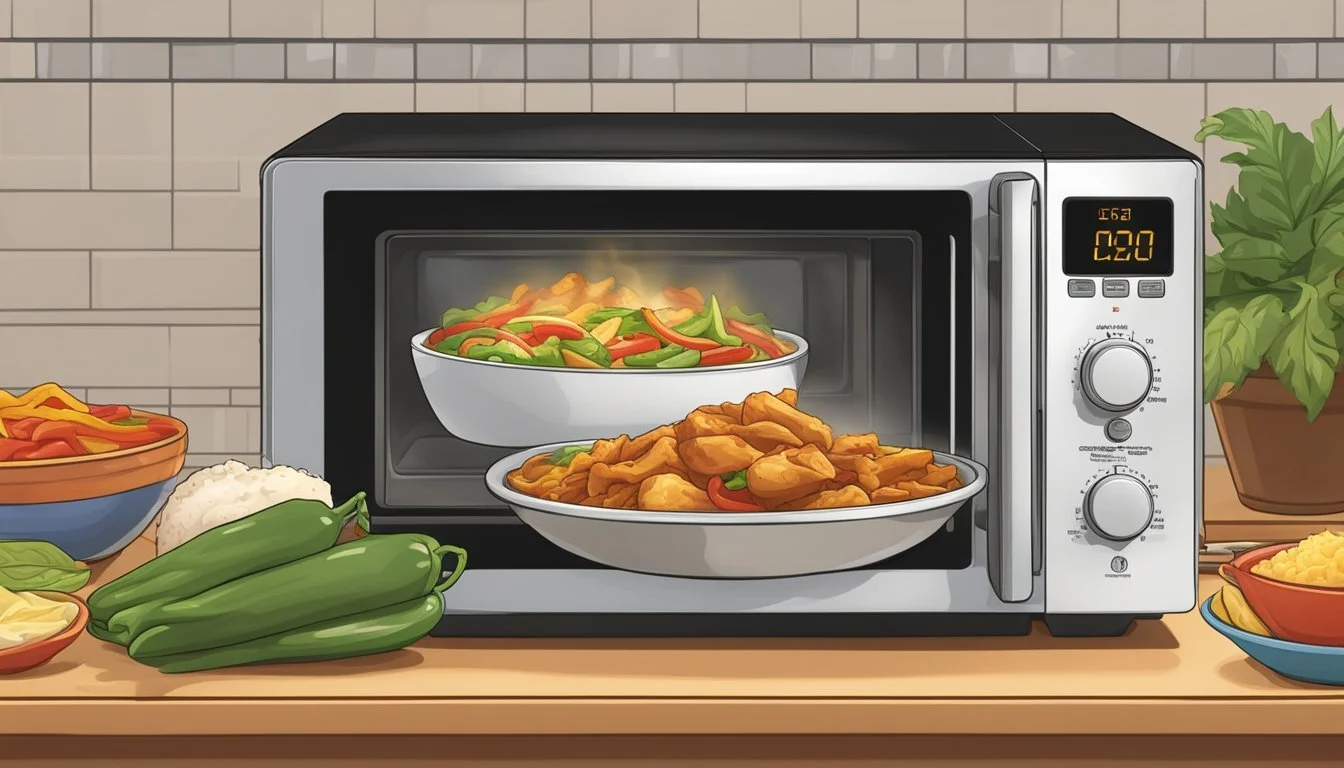Best Way to Reheat a Chicken Fajita Mix
Keeping Ingredients Moist
Reheating a chicken fajita mix can be tricky, as the key to preserving the flavor and texture lies in preventing the ingredients from drying out. This dish, typically a blend of chicken, peppers, onions, and spices, is a cherished Mexican staple known for its savory taste and vibrant colors. When it has been stored in the refrigerator, bringing it back to life without compromising its quality requires careful attention to method and timing.
To effectively reheat chicken fajita mix, the chosen method should ensure even heating while retaining moisture. Oven reheating is one such method that, if done correctly, can restore the dish to its near-original state. By covering the ingredients with foil before placing them in the oven, the steam is trapped, which helps in keeping the chicken and vegetables tender and juicy. Microwave reheating is a faster option but should be approached with caution as it can quickly lead to uneven heating and potential dryness. The key is to cover the dish and use a lower power setting to reheat the fajita mix gently.
Effective storage also plays a vital role in maintaining the quality of the fajita mix. Chicken fajitas are best stored in an airtight container in the refrigerator, where they can retain their flavors and moisture until ready to be reheated. Handling the mix gently and ensuring it is evenly spread out on the reheating tray can also contribute to a more satisfying end result, bringing the essence of a well-made chicken fajita mix back to the table.
Understanding Reheating Basics
Reheating chicken fajita mix properly is essential to maintain its moisture, texture, and flavor, while ensuring the food is safe to consume. This section will explore the various aspects that contribute to reheating leftovers effectively.
Effects of Temperature on Fajita Ingredients
The optimal temperature for reheating chicken fajitas plays a crucial role in preserving the quality of the ingredients. Excessive heat can cause chicken to become dry and tough, while vegetables may become overly soft and lose their texture. On the other hand, insufficient heating may result in a lukewarm meal that doesn’t provide the same sensory appeal as freshly cooked fajitas. It's recommended to aim for an internal temperature of 165°F as per USDA guidelines to ensure the fajitas are heated through properly.
Reheating Methods Overview
Various methods are available for reheating chicken fajitas, each with its own set of considerations:
Oven: Reheating in an oven preheated to 350°F, usually covered with foil to retain moisture, takes approximately 10-15 minutes.
Microwave: A quick method using medium power, typically covering the fajitas with a damp paper towel to introduce steam and prevent drying. A microwave-safe plate or an airtight container can be used, and it usually takes 1-2 minutes.
Stove/Pan: Using a pan over medium heat with a little bit of oil or water can help retain moisture. This method requires stirring for even heating, usually taking about 5-10 minutes.
Air Fryer: Though not commonly recommended, an air fryer could be used at a low temperature to quickly reheat the fajitas, ensuring they don’t dry out.
Health and Safety Considerations
Reheating chicken fajitas safely involves preventing bacterial growth by storing leftovers properly in an airtight container and refrigerating promptly. Leftovers should be consumed within 3-4 days. Always reheat to the safe internal temperature of 165°F to kill any potential bacteria. Additionally, it is not advised to reheat chicken fajitas multiple times as this can increase the risk of foodborne illnesses and further deteriorate the quality of the meal.
Pre-Reheating Preparation
Before reheating chicken fajitas, it’s crucial to prepare them properly to maintain their texture and taste. This preparation will ensure that the meat and vegetables are heated evenly without drying out.
Handling Leftover Fajitas
Leftover chicken fajitas should be stored in an airtight container and placed in the refrigerator to preserve their freshness. If the fajitas were refrigerated in a single container, they should be separated into their components: the tortillas set aside, and the meat and vegetables prepared for reheating. This separation is key to maintaining the optimal texture of each ingredient when reheated.
Adding Moisture to Prevent Drying
To keep the fajitas moist during reheating, introduce a small amount of moisture. One can either:
Sprinkle water lightly over the chicken and vegetable mix before reheating. Use only enough to moisten the ingredients without making them soggy.
Drizzle a bit of oil on the mix to help retain moisture and flavor.
Dividing Ingredients for Optimal Reheating
Dividing the fajita components is essential for even reheating. The meat and vegetables should be reheated separately from any cold ingredients such as sour cream or salsa. Foil can be used to cover the chicken and vegetable mix to prevent moisture loss during the process:
Aluminum foil: Wrap the mix in foil to create a seal that locks in steam and prevents drying.
Tortilla: Reheat separately or keep wrapped in a cloth to maintain warmth after heating by another method.
By following these steps, one ensures that the reheated fajitas will come out tasting great and with the correct texture.
Oven Reheating Technique
Reheating chicken fajitas in the oven effectively preserves the dish's moisture when done correctly, utilizing aluminium foil and carefully controlled temperature and timing.
Using Foil to Retain Moisture
To prevent moisture loss and maintain the succulence of chicken fajitas, one should employ aluminum foil. Here's the procedure:
Preheat the oven to 350°F (175°C).
Lay out a piece of aluminum foil and place the chicken fajita mix in the center.
Wrap the fajitas tightly in the foil to create a sealed 'packet', ensuring no steam can escape.
Place the foil packet on an oven-safe dish or tray.
This method helps maintain the integrity of the fajitas by trapping steam, which in turn prevents the dish from drying out.
Optimal Temperature and Timing
The precision in temperature and duration is crucial to achieve the best reheating results:
Temperature: Set the oven to 350°F (175°C), which is hot enough to warm the fajitas without overcooking them.
Timing: Place the wrapped fajitas in the preheated oven and reheat for about 10-15 minutes. Check periodically, as thicker cuts may require more time.
The judicious balance between temperature and time ensures that the chicken fajitas are heated through to the right temperature without sacrificing moisture or texture.
Stovetop Reheating Strategy
Reheating chicken fajita mix on the stove can preserve the tender texture of the chicken and the crunchy freshness of the vegetables when done correctly. Attention to heat level and pan selection is crucial to achieve the best results.
Maintaining Textural Integrity on the Stovetop
To maintain texture, one should slowly bring the ingredients up to temperature. A medium-high heat setting allows for an efficient yet gentle reheat. The goal is to warm the fajita mix thoroughly without overcooking it, which could lead to a loss of the desired textures. It is recommended to:
Preheat the pan or skillet before adding the fajita mix.
Stir frequently to ensure even heating and to prevent any ingredient from sticking to the pan or burning.
Utilizing Pans and Skillets
The choice of pan or skillet impacts the reheating process significantly. A non-stick pan is ideal for reheating because it requires less oil and reduces the risk of sticking. However, for those who prefer a slightly crisped exterior on the chicken and vegetables, a cast iron skillet may be the better choice. Here are specific instructions:
Heat the pan or skillet on medium-high heat.
If using a non-stick pan:
Add a small amount of oil or broth to avoid drying out.
Monitor closely to ensure the fajita mix doesn't start sticking.
If using a cast iron skillet:
Once heated, add the chicken fajita mix.
Stir consistently for an even reheat, adding oil or broth as necessary.
Using a cast iron skillet might also add a hint of char, enhancing the fajita's flavor, while the non-stick pan is more about quick and easy reheating with minimal cleanup.
Microwave Reheating Tips
When reheating chicken fajita mix in the microwave, maintaining moisture and texture is crucial. These tips ensure that the meat and vegetables are warmed through without losing their succulence.
Preventing Dryness in the Microwave
To combat moisture loss during microwave reheating, one can layer damp paper towels over the fajita mix. This creates a steamy environment, keeping both the meat and vegetables from drying out. Additionally, using a microwave-safe plate alongside a cover, such as microwave-safe plastic wrap or an inverted dish, helps to trap moisture inside. It’s important to heat at short intervals, checking frequently, which allows one to gauge the warmth without overdoing it.
Layering Ingredients on the Plate
One should strategically arrange the fajita components on the plate to ensure even reheating. Start by spreading the chicken and vegetables in a single, even layer on the microwave-safe plate. If tortillas are to be included, they should be wrapped in a damp paper towel and heated separately to preserve their texture. One should also consider reheating the components in stages, starting with the meat, as it generally requires more time to reheat than vegetables do.
Alternative Reheating Appliances
Reheating chicken fajitas without sacrificing the texture can be a challenge. Fortunately, alternative appliances such as air fryers and toaster ovens offer solutions that maintain the ingredients' moisture and crispiness.
Utilizing the Air Fryer for Quick Results
Air fryers are adept at circulating hot air around the food, which can quickly and evenly reheat chicken fajitas without drying them out. For optimal results, one should preheat the air fryer to a moderate temperature, around 350°F (175°C). Place the chicken fajitas in the air fryer basket, ensuring they are not overcrowded, as this might prevent them from reheating evenly. It's generally recommended to reheat the fajitas for about 3-4 minutes, checking periodically to ensure they do not overcook.
Reheating Chicken Fajitas in Toaster Ovens
Toaster ovens function similarly to traditional ovens but on a smaller scale, which can be more convenient for reheating single servings. Reheat fajitas at a temperature of 350°F (175°C), using the toaster oven's bake setting for 5-7 minutes. To maintain the fajitas' moisture, one can add a small amount of water to the oven-safe dish before covering it with foil. The steam generated will help keep the fajitas moist. One should monitor the fajitas closely since toaster ovens can vary in power and efficiency.
Serving and Accompaniments
The right serving techniques and accompaniments can elevate a reheated chicken fajita mix, maintaining flavor and ensuring a pleasurable dining experience.
Warming up Tortillas and Toppings
Tortillas: For an authentic experience, one should warm tortillas before serving. A skilled approach is to heat them in a skillet over medium heat for 30 seconds on each side or wrap them in foil and warm in an oven preheated to 350°F (175°C) for about 15 minutes.
Toppings: To enhance the fajitas, one can provide a variety of toppings, served at their best temperature to complement the warm fajita mix. These can include:
Guacamole: Serve it chilled to offer a creamy and rich taste.
Sour Cream: It should also be served cold, adding a tangy contrast.
Cheese: Shredded cheese may be sprinkled on top of the hot fajita mix to allow it to melt slightly.
Lettuce: Fresh, crisp lettuce adds a cool crunch.
Salsa: A room temperature or slightly chilled salsa can add a juicy and spicy kick.
Pairing with Proper Side Dishes
A thoughtful selection of side dishes can balance the meal and cater to varied tastes, including:
Beans: Refried beans or whole black beans contribute a hearty element, often served warm.
Rice: A side of Mexican rice provides a subtle, savory flavor, typically served hot.
Pair these sides in such a way that their warmth and flavors don't overpower but rather complement the fajita mix. It's important that each component retains its texture and taste integrity to complete the authentic fajita experience.
Storage and Food Preservation
Properly storing chicken fajita mix not only ensures safety but also retains quality for effective reheating. Utilize both refrigeration and freezing to prolong freshness, employing techniques that prevent drying out when the mix is later reheated.
Proper Refrigeration Techniques
To store leftover fajitas in the refrigerator, one should transfer the mix into an airtight container or wrap it tightly with plastic wrap to minimize exposure to air. This method helps in preventing the mix from drying out and absorbing other flavors from the fridge. The chicken fajita mix should be cooled to room temperature before placing it in the refrigerator to prevent raising the refrigerator's internal temperature, which can lead to bacterial growth. The ideal temperature for your fridge should be below 40°F (4°C) to ensure the food's safety and to keep it well-preserved for future reheating.
Tips for Refrigeration:
Cool chicken fajita mix before refrigerating.
Use plastic airtight containers or securely wrap in plastic.
Keep refrigerator below 40°F (4°C).
Freezing and Thawing Fajita Mix
When freezing chicken fajita mix, it's best to portion out the leftovers before freezing; this makes it simpler to thaw only what is needed for a subsequent meal. Use heavy-duty freezer bags or airtight plastic containers to store the mix in the freezer. Label each container or bag with the date of freezing to keep track of how long the fajitas have been stored.
For thawing, the fajita mix should be transferred from the freezer to the refrigerator and allowed to thaw overnight. One should avoid thawing at room temperature as it poses a risk for bacterial growth. Once thawed, fajitas are best reheated to an internal temperature of 165°F (74°C) for food safety.
Tips for Freezing:
Store in heavy-duty freezer bags or airtight containers.
Label with the freezing date.
Portion out for easy thawing and reheating.
Tips for Thawing:
Thaw in the refrigerator overnight.
Do not thaw at room temperature.
Reheat to an internal temperature of 165°F (74°C).




